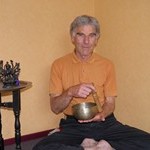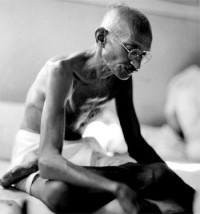by John Guthrie
Sitting quietly, the dawn chorus yet to begin, I think of that one word, compassion.
The image of a hermit in a cave somewhere comes to mind, and I reflect on this as the embodiment of compassion.
Away from the world, yet radiating out the peace that arises from compassion, which has been birthed in the depth of their silence. A place that could just as well have its roots in suffering.
There are those whose compassion has arisen from personal suffering.
In the last one hundred years the likes of Mahatma Gandhi, Martin Luther King, the Dalai Lama, Nelson Mandala and Mother Theresa have been an inspiration to all.
These are the ones we know, for the really encouraging thing is the ones we do not so readily hear about, yet are out there in the world quietly going about their good works and bringing some solace and joy into the hearts of many whose lives have taken them on a less than fortunate path.
One such person is the reverend Ruth Wright who in a desolate district of Vancouver in Canada begins her day at five am to administer to the needy at her First Uniting Church.
There is no judgement of how these people made their choices in life. Ruth acts to address their immediate needs be it a cup of coffee, a bowl of soup, a blanket or advocacy.
She is not alone in her work, she has helpers, but it is the extraordinary strength and example of one person who acts without need of thanks, that gives inspiration to many. Her work is truly compassionate and embodies what we call in the Bhagavad Gita, Karma Yoga. (1)
Karma Yoga is compassion in action
In a rural setting we have in India, Vandana Shiva who has worked on behalf of thousands of destitute Indian farmers, in her campaign against genetically modified organisms and the corporate world of the chemical and seed industry.
She is not a Ruth Wright, yet the work of each is equally important for they use the gifts life has given them for the greater benefit of our World. (2)
So compassion does not only arise only from the hermit’s cave.
Though it still has a place, if personally and culturally there is a calling for this. One can not deny a calling. Compassion as well belongs out of the cloister and cave.
The above mentioned people are shining examples of compassion in action. They can indeed inspire us to find our compassion which is a seed in us all waiting to germinate.
This is what our world needs so desperately now; an active compassion, nurtured and working in society.
One finds one’s dharma in compassion.
Compassion requires first and foremost, Satya, truthfulness. It does not require us to be perfected enlightened beings. In the broadest context it is truthfulness in all aspects of living.
Compassion can be cultivated. Few of us can be instantly free from our personal judgements, bitterness, anger, and negative emotions.
Compassion weeds out negative attributes. It is like a garden, you tend, cultivate and nourish it. One can feel a garden that is loved as soon as you step into it.
The relevance of yoga in society is to walk the path of compassion.
More than ever, because there are so many of us now who inhabit the earth and because of huge “footprints” upon the environment, the individual cultivation of compassion is required. Many of see that established systems of governance, economics, finance and agricultural are failing in their heaviness and abuse of power.
How do we find compassion in the wrong doing of our leaders? What is the political, social and economic reality of compassion?
For this is what it comes down to. Perhaps an easy solution would be to use our spiritual intellect and say there is no right or wrong they are merely expressions of duality. It is the divine drama being played out. Though this could be a spiritual delusion.
Is there a system or systems that can create harmony in our world? Or is each of us individually called to enquire and question, without judgement or blame, our place in the world today?
In meditation it is fine to feel that deep peace and love filling our body and all layers of existence. To experience how it does radiate out. It is very important to experience this.
It is also important that it moves off the yoga mat to create positive practical action in our world.
There is no easy way, though this is the calling of our times. After all the Buddha and Christ did not stay on their mat. Meditation gives one the strength to be in the world, without being swallowed, swamped or crushed by it.
Once we find that energy of compassion can it become a never ending spiral of energy that reaches out into the universe?
The universe being a space that our earth bound minds struggle to perceive, for it reaches into nothingness where it actually contains all creation. It would seem obvious that this be so for how else can material substance arise.
In that universal space, no judgement, no concept, indeed perhaps no thought can be possible.
Is compassion therefore not in its ultimate expression a pure energy that is neither love, nor hate, nor any duality? Compassion is the life force of the universe that enables us to exist as human beings. Could it also be the life force that enables all creation to exist?
Compassion is a two fold experience. One being of action in the world, the other making a connection to something that is far greater than the individual and social perception of reality.
Coming back to the yoga mat. If our yoga practice is one that revolves around asana, then which asana enables us to embrace compassion?
I think we can find it in Savasana. As the body relaxes and releases tensions through the physical, emotional, mental and spiritual aspects of our being, the nervous system can come into balance which then begins to initiate a balance in the Chakra system.
In an open state we are able to experience the energy of our heart, of Anahata Chakra. With a focused mind we can direct this energy through ourselves and then out into the world. We can then carry this energy with us into our daily lives and actions.
Footnotes:
(1) The reverend Ruth Wright was featured in the March 2000 issue of Ascent magazine, which focused on Karma Yoga.
(2) Vandana Shiva was profiled in the December 2002 issue of Ascent magazine and then featured in the March 2006 issue.
About John Guthrie:

John began his yoga journey in December 1977, when by chance, he found himself at ‘The Institute of Yogic Culture in Trivandrum,’ South India.
He travelled through India, Ladakh and eventually to Sri Lanka where he spent time in two different hermitages, learning Vipassana meditation. In 1979, he returned for further training to the Yoga Institute in Kerala.
At the end of 1979 John travelled to Europe and met his wife Dominique in France. In 1981 they arrived in New Zealand and established a biodynamic property in the Waimate district.
In 1992-93 John did the IYTA (NZ) Diploma Teaching Course and in 1997 completed the post graduate short course ‘The Release of Tension through Yoga’.
John currently teaches nine Yoga classes, and two modified Tai Chi classes a week. He is enthusiastic about the place of Yoga in society, has a love of the natural world, enjoys writing poetry and has begun to practice massage once again. You can reach John via email here.


Leave a Reply